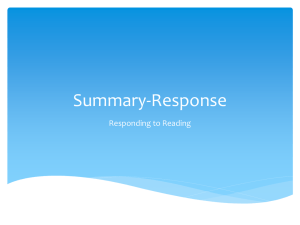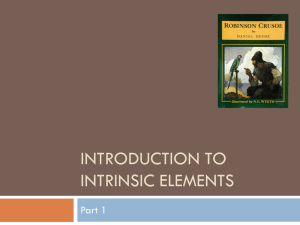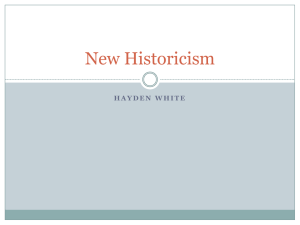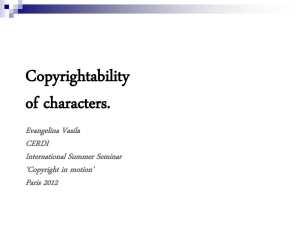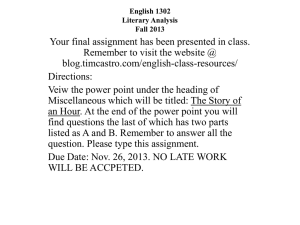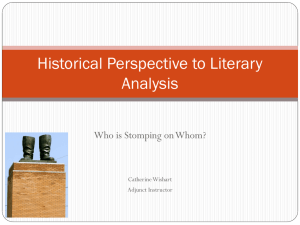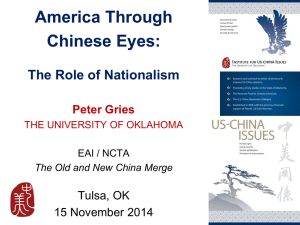LITERATURE - College of Alameda
advertisement
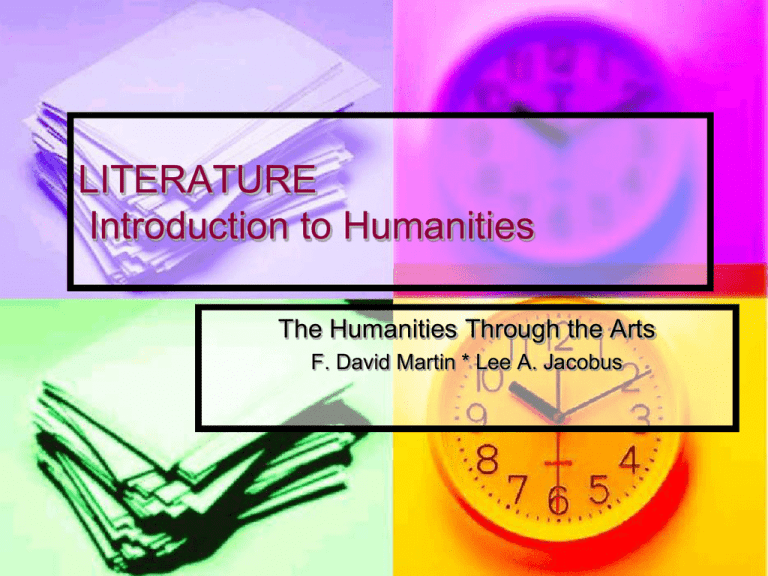
LITERATURE Introduction to Humanities The Humanities Through the Arts F. David Martin * Lee A. Jacobus Spoken language is the basic medium of literature. Literature is an art whose medium is language used to affect the imagination. Words themselves can evoke a response even when they are spoken independently of a grammatical setting, such as a sentence. Fiction writers and poets share many of the techniques of literature because their effects depend on universal language art. Subject matter, Artistic Form, and Content We can describe the subject matter and form, But we can only point to the content, For the content is being said. There is no other way of saying it, Because to change even one word changes the sound and changing the sound changes the meaning and in turn, the content. Subject Matter and Artistic Form The subject matter can be described: a boy’s agony in face of his dying father’s submissiveness Much can be said about the form: the way, the sounds are organized and how they relate to the sense. Literature as spoken language Treating literature as spoken language points up its relationship to other serial arts such as music, dance, and film. Literature happens in time. In order to perceive it, we must be aware of what is happening now, remember what happed before and anticipate what is to come. A Work of Literature A work of literature is, in one sense, a construction of separable elements like architecture. The details of a scene, a character or event, or a group of symbols can be conceived of as the bricks in the wall of literary structure. If one of these details is imperfectly perceived, our understanding of the function of that detail – and, in turn, of the total structure - will be incomplete. The Literary Theme The theme (main idea) of a literary work is usually a structural decision, comparable to an architectural decisions. Decisions about the sound of the language, the characters, the events, the setting, Are comparable to the decisions regarding the materials, size, shape, and landscape of architecture. Literature as works of elements It is helpful to think of literature as works composed of elements that can be discussed individually in order to gain a more thorough perception of them. And it is equally important to realize that the discussion of these individual elements leads to a fuller understanding of the whole structure. Literary Terms The Narrative and the Narrator The Narrative is a story told to an audience by a teller controlling the order of events and the emphasis those events receive. Most Narratives concentrate upon the events. But some narratives have little action. Sometimes the Narrator is a character in the fiction…The author controls the narrator and through the narrator leads the reader. And reveals depth of character through responses to action. Literary Terms The symbol, simile, metaphor, images, and diction (word choices) are the main details of literary language that we will examine. All these details are found in poetry, fiction, drama, and even the essay. Literary Terms Language has denotation: a literal level where words mean what they obviously say, And connotation: a subtler level at which words mean more than they obviously say. The Episodic Narrative The term episodic describes one of the oldest kinds of literature, Often used in epics, such as Homer’s Odyssey. The overall structure of the story centering on the adventures of Odysseus, but each adventure is almost a complete entity in itself. Narratives cont’d We develop a sense of the character of Odysseus as we follow him in his adventures, but this does not always happen in episodic literature. Often the adventures are not only completely disconnected from one another, but the thread that is intended to connect everything – the personality of the protagonist (main character) is not strong enough to keep things together. The Organic Narrative The term organic implies close connectedness in the parts of the structure. The organic narrative connects every action and every character in subtle ways so that as the narrative unfolds, the reader is given more and more information about all the events of the story. THE QUEST NARRATIVE The quest narrative is simple enough on the surface: a hero sets out in search of a valuable treasure that must be found and rescued at all cost. Such, in simple terms, is the plot of almost every adventure yarn and adventure film ever written. Quest Narrative cont’d Herman Melville’s Moby Dick, the story of Ahab’s determination to find and kill the white whale that took his leg, is a quest narrative. It achieves unity by focusing on the quest and its object. The novel is centered on the question of good and evil. But as it progresses, the actions of the novel begin a reversal of values – hallmark for quest narratives. The Quest Narrative The quest structure in Ralph Ellison’s Invisible Man is so deeply rooted in the novel that the protagonist has no name. We know a great deal about him because he narrates the story and tells us about himself. He is Black, southern, and as a young college student, ambitious. Quest Narrative Cont’d His earliest heroes are George Washing Carver and Booker T. Washington. He craves the dignity and the opportunity he associates with their lives. But things go wrong. He is dismissed unjustly from his college in the south and must, like Odysseus, leave home to seek his fortune. Quest Narrative cont’d He imagines himself destined for better things and eagerly pursues his fate, finding a place to live and work up North, Beginning to find his identity as a black man. He discovers the sophisticated urban society of New York City, the political subtleties of communism, the pains of black nationalism, and the realities of his relationship to white people, to whom he is an invisible man. Quest Narrative cont’d Yet he does not hate the whites, and in his own image of himself he remains as invisible man. The novel ends with the protagonist in an underground place he has found and which he has lighted, by tapping the lines of the electric company, with almost 200 electric light bulbs. Quest Narrative cont’d Despite this colossal illumination, he still cannot think of himself as visible. He ends his quest with out discovering who he is beyond this fundamental fact: he is invisible. Black or white, we can identify in many ways with this quest, for Ellison is showing us that invisibility is in all of us. THE LYRIC The lyric structure is virtually always a poem, primarily reveals a limited but deep feeling about something or event. The lyric is often associated with the feelings of the poet, although we have already seen that it is not difficult for poets to create narrators distinct from themselves and to explore hypothetical feelings. The Lyric cont’d If we participate we find ourselves caught up in the emotional situation of the lyric. Poets can understand and interpret emotions without necessarily undergoing them. The lyric has feeling – emotion, passion, or mood – as basic in its subject matter. LITERARY DETAILS Literature with reference to structure, the overall order within every structure are details that need close examination in order to properly perceive the structure. Literature uses language to reveal meanings that are usually absent from daily speech. Image, metaphor, symbol and diction are central to literature of all genres. LITERARY DETAILS THE IMAGE An image in language asks us to imagine or “picture” what is referred to or being described. Most images appeal to our sense of sight, but sound, taste, odor, and touch are often involved. One of the most striking resources of language is its capacity to help us reconstruct in our imagination the “reality” of perceptions. LITERARY DETAILS The Metaphor Metaphor helps writers intensify language. Metaphor is a comparison designed to heighten our perception of the thing compared. Poets or writers will usually let us know which of the things compared is the main object of their attention. LITERARY DETAILS The Symbol The symbol is a further use of metaphor. Being a metaphor, it is a comparison between two things; but unlike most perceptual and conceptual metaphors, only one of the things compared is clearly stated. The symbol is clearly stated, but what it is compared with (sometimes a very broad range of meanings) is only hinted at. LITERARY DETAILS Symbols cont’d For instance, the white whale in Herman Melville’s novel, Moby Dick, is a symbol both in the novel and in the mind of Captain Ahab, who sees the whale as a symbol of all the malevolence and evil in a world committed to evil. We may believer that the whale is simply a beast and not a symbol at all. LITERARY DETAILS Symbols cont’d Or, we may believe that the whale is a symbol for nature, which is constantly being threatened by human misunderstanding. Such a symbol can mean more than one thing. It is the peculiar quality of changing. Symbols are usually vague and ambiguous. LITERARY DETAILS Symbols cont’d The most important thing to remember about the symbol is that it implies rather than explicitly states meaning. LITERARY DETAILS DICTION Diction refers to the choice of words. Writing involves the choice of words, the term “diction’ is usually reserved for literary acts (speech as well as the written word) Words chosen especially for their impact. “To be, or not to be.” The diction of a work of literature will sometimes make that work seem inescapable, as if there were no other way of saying the same thing. Diction cont’d The careful use of diction can sometimes aid a satirist, whose intention is to say one thing and mean another. So the careful use of structural diction can sometimes conceal a writer’s immediate intention, making it important for us to be explicitly aware of the diction until it has made its point. -30-
